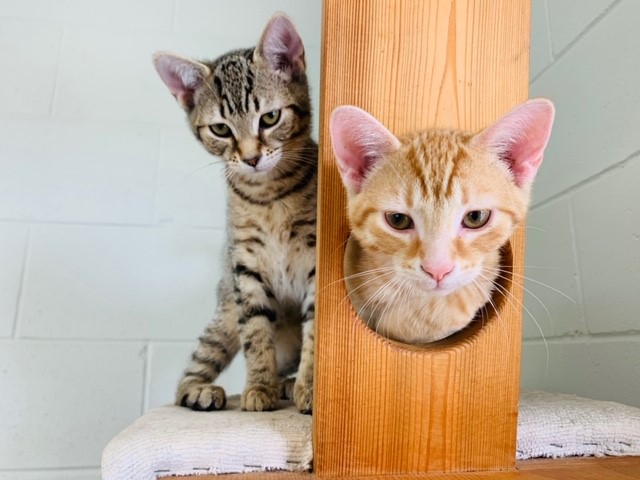Kitten diarrhea: Normal upset or sign of serious trouble?
by Ontario SPCA and Humane Society | Interesting | June 4, 2024

Guest blog by Dr Emmanuel Fontaine, Scientific Communications Veterinarian at Royal Canin North America
Kitten diarrhea manifests as unusually frequent and watery bowel movements, a clear sign that their digestive system is out of balance. And you might think you know the basics of diarrhea, but don’t be fooled – it’s a complex condition with many faces.
And to truly grasp its severity, you need to zero in on four critical indicators: stool consistency, color, smell, and any accompanying symptoms.
These are your keys to unlocking the mystery of your kitten’s health woes. Bear in mind, these indicators serve as your initial safeguard. Examining them is imperative for assessing the severity of your kitten’s state and determining the necessary actions to protect their well-being.
Navigating stool consistency: Your guide to fecal chart analysis
Indeed, we veterinarians have a fondness for charts, and for good reason—they’re incredibly practical, particularly when it comes to kitten diarrhea.
In my experience, many clients have mistakenly believed their kittens were suffering from diarrhea, when in fact, their condition was normal.
They were simply unaware of the key indicators to watch for.
Such misunderstandings and the resulting worry could have been effortlessly averted with the aid of fecal charts.
Practical tip: when you look up these charts online, you’ll find a plethora of them, each employing its own scoring system.
For example, a score of 7 might signify watery diarrhea on one chart, whereas on another, it’s indicated by a score of 1.
Despite these differences, they all aim to lead you to a consistent understanding of stool consistency. Therefore, before you talk about a fecal score with your vet, make sure to clarify which chart you’re referencing!
I strongly advise all new kitten parents to keep a fecal chart within easy reach.
Consider printing a chart and displaying it prominently, so that everyone involved in the kittens’ care is on the same page about what constitutes normal versus abnormal stool.
After all, in these situations, being informed is truly empowering!
Hue guide: Understanding stool color variations in diarrhea
The hue of your kitten’s stool is far more than a minor detail—it’s a vital glimpse into their health – and I’m completely serious about this.
The shade of diarrhea can significantly reveal the gravity of a kitten’s health issue.
A healthy kitten’s stool typically boasts a rich brown tone, indicative of a well-functioning digestive system.
Yet, in the realm of cat health, stool colors span a wide range, each narrating a unique aspect of their condition.
For kittens, there are three specific stool colors that demand attention, as they may indicate various health concerns.
The following table provides a breakdown of these colors, their potential meanings, and recommended actions if spotted in conjunction with diarrhea.
| Color | What it Means | What To Do |
| Black | Very dark, almost tar-like black stools is indicative of digested blood in the gastrointestinal tract.
This color change is a result of internal bleeding, where the blood has had time to be partially digested, giving the stool its distinctive dark appearance. |
This symptom is a serious warning sign and requires immediate veterinary attention.
This is something sometimes observed in cases of feline panleukopenia.
|
| Red | Red in the stools indicates the presence of blood, signaling an injury of some sort within the digestive tract | Anytime you observe a high quantity of blood in the stools (almost liquid, very often associated with a foul smell), especially in the case of severe diarrhea, this is an emergency. Consult with your veterinarian as quickly as possible here.
One exception: when the blood appears as streaks or spots of bright red within the stool. This fresh, undigested blood suggests irritation or inflammation in the lower part of the gastrointestinal tract, such as the colon or rectum. The presence of blood in this form is a clear indicator of the irritation caused by the coccidia parasites in the intestinal lining. While consulting your veterinarian is crucial in this situation, it doesn’t typically necessitate an emergency visit, unless, of course, there are other concerning symptoms accompanying it.
|
| Yellow | Stools ranging from light green to mustard yellow typically indicate the presence of undigested fat.
This coloration is commonly seen in cases of Giardia infection, although other parasites can also cause this symptom. The distinct yellow hue serves as a clear signal to investigate further for potential parasitic infections. |
Consultation with a veterinarian is also required here. |
TABLE Stool Color Significance: Interpreting Meanings in Cases of Kitten Diarrhea
Smell signals: Investigating unusual stool odors in kittens
The odor emanating from your kitten’s stools offers insight into their health status.
Typically, the scent of a kitten’s stool is subtle and not particularly offensive, aligning with what’s expected from a healthy animal.
Yet, if the stool’s odor turns intensely sharp, acrid, or disagreeable, it may signal underlying issues.
Such out-of-the-ordinary smells can point to various problems, ranging from dietary missteps to infections or digestive disturbances.
Should you detect a consistently strong and offensive odor from your kitten’s stools, it’s more than an inconvenience—it’s an indicator that a veterinary check-up is necessary.
A particularly foul smell from a kitten’s stool can indicate necrosis, or tissue death, within the digestive tract, signaling severe damage or disease.
This alarming symptom underscores the urgency of seeking immediate veterinary care to address the potentially grave condition.
More than diarrhea: Key warning signs in kittens
Diarrhea in kittens warrants close observation for other clinical indicators that might signal a deeper health concern.
Symptoms such as reduced energy, appetite loss, vomiting, dehydration, and diminished interest in play or usual activities are alarming, particularly when they accompany diarrhea.
These symptoms could be the telltale signs of serious health issues needing prompt veterinary care.
A drop in energy or appetite could point to a broader illness, and dehydration in kittens can escalate to a critical state rapidly. Vomiting, along with diarrhea, heightens the risk of dehydration and suggests significant digestive distress.
Prompt action upon noticing these signs in your kitten is crucial.
Using growth charts for effective kitten care
Here’s an invaluable tip that could significantly impact your approach to kitten healthcare: leveraging pediatric growth charts in their early stages.
These charts are more than mere measures of physical size; they’re crucial for spotting developmental concerns. Particularly in instances of diarrhea, they can offer substantial insights.
A noticeable weight drop in a kitten, marked by a descent across two centile lines on their growth chart, raises major alarms.
Such a shift is not merely a deviation from expected growth trajectories but a stark indication of a potentially severe health issue.
Observing such a growth alert is a definitive cue that your kitten needs immediate veterinary attention.
In the formative stages of a kitten’s growth, these charts are VERY helpful; they are true game changers in my opinion. They provide critical data that can guide timely and informed decisions about your kitten’s health care needs for sure!
——————————————————————————————————————————-
 Emmanuel Fontaine graduated from the Toulouse Veterinary School in 2004, he continued his studies at the Alfort Veterinary School (Paris) as a trainee Vet in the domestic carnivore unit of the Reproduction Department. From 2005 to 2011, he worked at the Centre d’Étude en Reproduction des Carnivores (CERCA) [Research Centre for Reproduction in Carnivores], a unit specializing in pet breeding assistance. Emmanuel Fontaine is also qualified at the European College for Animal Reproduction (ECAR) and completed his PhD in 2012 on the use of GnRH agonists in canines. From September 2011 to September 2018, he worked as Technical Services Veterinarian for the PRO team at Royal Canin Canada. He then was in charge of Scientific Communication for the Americas until August 2022. He now works as a Senior Scientific Communications Veterinarian for Royal Canin North America.
Emmanuel Fontaine graduated from the Toulouse Veterinary School in 2004, he continued his studies at the Alfort Veterinary School (Paris) as a trainee Vet in the domestic carnivore unit of the Reproduction Department. From 2005 to 2011, he worked at the Centre d’Étude en Reproduction des Carnivores (CERCA) [Research Centre for Reproduction in Carnivores], a unit specializing in pet breeding assistance. Emmanuel Fontaine is also qualified at the European College for Animal Reproduction (ECAR) and completed his PhD in 2012 on the use of GnRH agonists in canines. From September 2011 to September 2018, he worked as Technical Services Veterinarian for the PRO team at Royal Canin Canada. He then was in charge of Scientific Communication for the Americas until August 2022. He now works as a Senior Scientific Communications Veterinarian for Royal Canin North America.
Categories
Testimonial
As an animal lover all the work you do
As an animal lover all the work you do to help ensure that every dog and cat can find their forever home that is filled with love is greatly appreciated.
